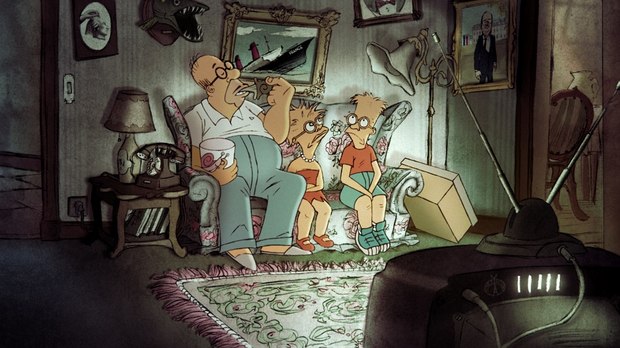Three-time Oscar nominee Sylvain Comet discusses French stereotypes, animation techniques, and creating his couch gag for ‘The Simpsons.’
Celebrated th1ng director/animator Sylvain Chomet (The Triplets of Belleville, L'illusionniste, The Old Lady and the Pigeons) recently released a making-of video for his Couch Gag for The Simpsons, which aired back in March.
The three-time Oscar nominee’s decidedly French take on The Simpsons saw Homer eat snails, Bart make his own foie gras, and Maggie trapped between Homer’s butt cheeks. The making-of video details Chomet’s process for creating the couch gag, which included adding his own visual style to the iconic Simpsons family before animating each character by hand, adding digital color, and final compositing.
Watch the making-of video, and read AWN’s Q&A with Chomet and th1ng founder and executive producer Dominic Buttimore, below:
Q&A with Sylvain Chomet and Dominic Buttimore

Sylvain Chomet and Dominic Buttimore
How easily does The Simpsons humor translate to French audiences?
Sylvain Chomet: The humor translates to some French audience, and doesn’t to others. The online reactions to the couch gag in France vary from “brilliant” to “are the Americans making fun of the French?”
Like your feature The Triplets of Belleville, the couch gag has no dialog. Was that one of the elements that initially attracted you to the project?
SC: I might say that there is a little bit of dialogue in the couch gag when Marge says “Où est Maggie?” (“Where is Maggie?). Otherwise, I like the humor and expression that you get from drawings without dialogue – it felt right this way.
As far as requiring dialogue in the sequence, there was no restriction given to us by Matt Groening and Al Jean, the Executive Producers of The Simpsons. If there was additional dialogue in the sequence, I’m sure we would use French if, and when, they spoke.
Your gag is a play on stereotypes, turning the tables on the concept of what it means to be “French” or “American.” What inspired you to take this approach?
SC: To me, it seemed to be the right approach. After all, the American Simpsons is full of stereotypes, it’s what makes it funny and Americans are able to laugh at themselves and how others see them through the show. I wanted to do the same for the French -- use clichés and French stereotypes such as eating snails, making foie gras, etc., so that we are able to laugh at ourselves and also at how others perceive us.
As an artist and a director, what can you say with 2D that you can't say -- or can't say as well -- in 3D/CGI?
SC: They are very different techniques. 3D is essentially a “puppet” animation, more akin to stop motion. I like the 2D technique as it allows for plenty of freedom in the animation. A single drawing is funny, but it’s funniest when it moves. It is very hard for a single frame of a CGI animated character to be as funny.
Describe the “unforgiving nature” of hand-drawn animation in relation to television production. What are some of the biggest challenges?
Dominic Buttimore: Hand-drawn animation is probably the most difficult type of animation to create at a high level. Unlike 3D CGI, we are unable to adjust scenes, camera moves, etc. without complete reanimation.
The techniques used by Sylvain and our artists remain unchanged for over 90 years. Basically, the skill of the animator is revealed through a piece of paper and a pencil. Having said all this, drawn animation is not particularly slow in comparison to any other type – it’s clear stages (design/ boarding/ animatic/pencil test) need careful consideration before moving on. The ultimate challenge is always getting the best work done creatively, within the time and budget, and that’s nothing new!
What are some of the tools and techniques that help you meet these challenges?
DB: Our basic animation tools are paper, pencils and our artists’ skill. However, all the processes after the drawings are complete are now digital and help speed up the work and add creative flexibility. We scan the drawings to allow for digital coloring, usually in Animo, before composting in After Effects or Nuke. The background line work is usually by hand and the color is added digitally, to give the overall effect of a hand colored piece.
What was the timetable for the project? Were there changes? How were they achieved?
DB: We completed the whole piece in about ten weeks. Production went very smoothly with Sylvain and the team at th1ng. They all knew each other well and were striving for the same goal, so internally there were very few tweaks to the work. The Simpsons’ team, Matt Groening and Al Jean were absolutely appreciative the whole way through. They loved the idea on paper, were delighted with the storyboard and “couldn’t stop laughing” when they saw the final piece. It was a dream job in many ways – great freedom for Sylvain to create the sequence, a very appreciative client and a great crew.
How difficult was it working on a TV schedule and budget compared to working on a feature?
SC: The budget wasn’t an issue in this situation as the project was such fun -- we gave it our all like we always do. The team at th1ng was brilliant and that is what makes the difference between projects, whether they are produced for film or TV. The production was highly efficient and the animation was beautiful. It is certainly the core team that I will be using on my next long-form animation piece.
Source: Th1ng














